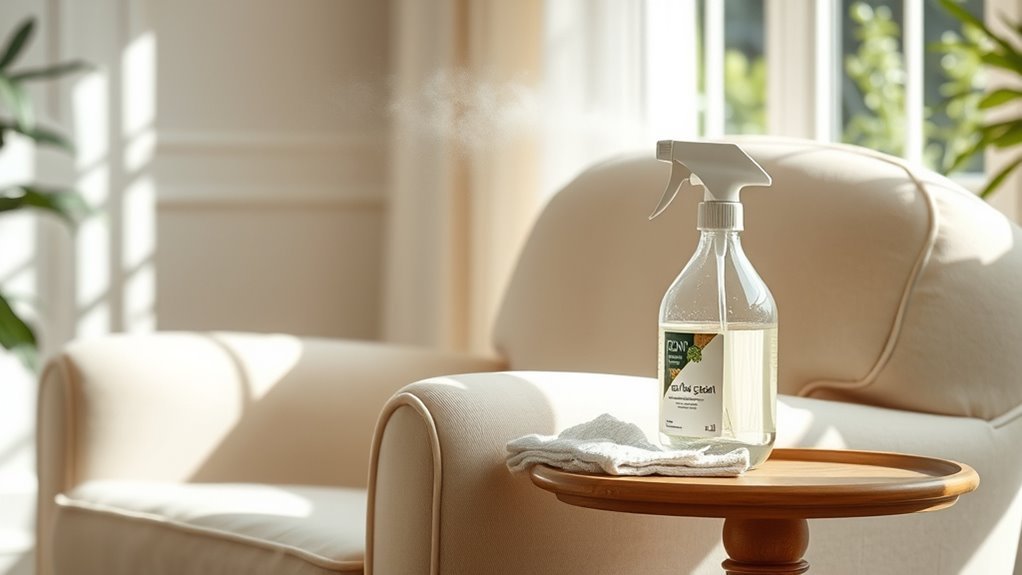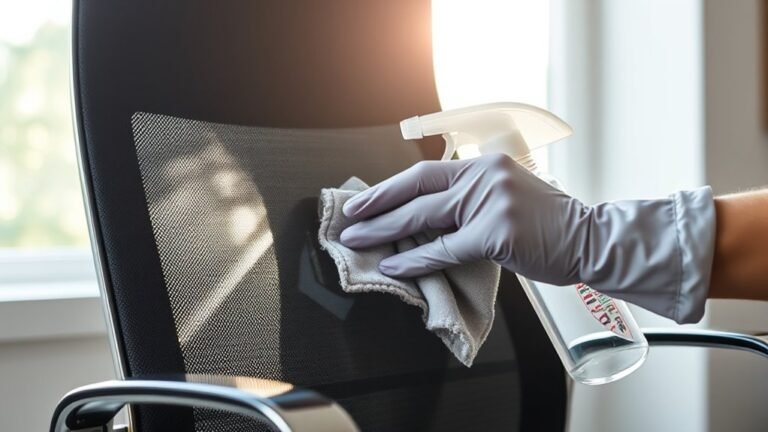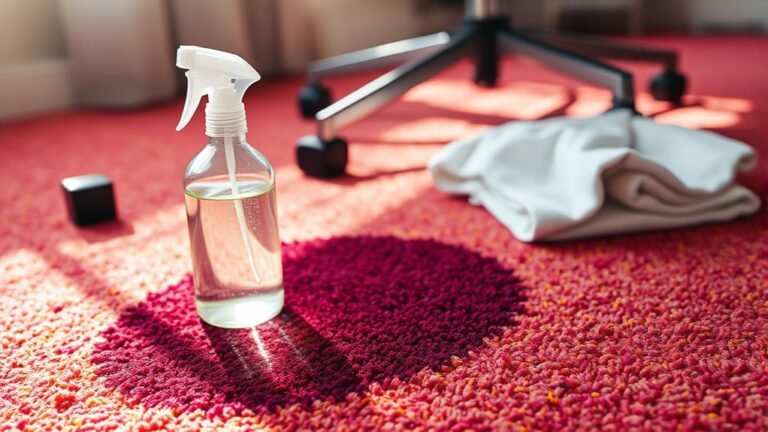How to Clean Your Chair Safely
To clean your chair safely, first identify its material—fabric, leather, wood, or metal—to choose the right cleaning method. Use gentle cleaners or natural solutions, and always test on a hidden spot. Vacuum or dust before applying moisture, and avoid harsh chemicals that could damage fibers or finishes. For leather, wipe spills quickly and condition regularly. Proper drying prevents mold and keeps your chair fresh. Following simple care steps guarantees your chair stays comfortable and durable; there’s more you can do to maintain and protect it.
Assessing the Material of Your Chair
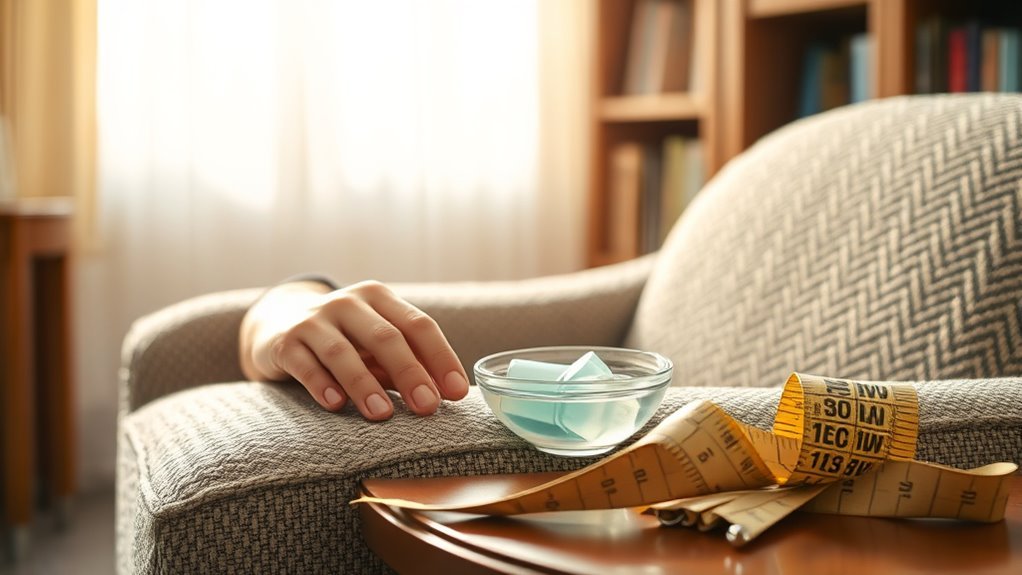
Before you start cleaning, you need to identify what material your chair is made of. Knowing the material types and chair finishes is crucial because each demands a different cleaning approach to keep you from damaging your chair. Whether it’s leather, wood, metal, or fabric, each material reacts uniquely to cleaning agents and techniques. Recognizing the finish, like matte, gloss, or lacquered, also guides you in choosing the right method. You want to maintain your chair’s integrity without restrictions, so understanding its makeup lets you clean confidently and effectively. Take a moment to check labels or manufacturer instructions if available. By pinpointing the exact material types and finishes, you guarantee your chair stays fresh and free, ready for your next adventure without being tied down by improper cleaning.
Gathering the Necessary Cleaning Supplies
Before you start cleaning, make sure you have the right tools on hand. You’ll need essential items like a soft brush, microfiber cloth, and a vacuum. Choosing the right cleaning solution based on your chair’s material is just as important to avoid damage.
Essential Cleaning Tools
Although cleaning your chair might seem straightforward, having the right tools on hand will make the process much easier and more effective. You’ll want to gather essential cleaning tools that suit your chair’s material and your personal preferences. Start with a soft-bristled brush or microfiber cloth to gently remove dust and dirt without damaging surfaces. A handheld vacuum can be handy for deep crevices. When selecting cleaning products, consider eco friendly options—they’re safer for you and the environment, letting you clean freely without worrying about harsh chemicals. Also, having a spray bottle for water or diluted solutions helps control moisture. With these tools ready, you’re set to clean confidently, enjoying both a fresh chair and peace of mind.
Suitable Cleaning Solutions
Choosing the right cleaning solutions is key to keeping your chair looking its best without causing damage. You want to feel free from harsh chemicals, so opting for eco friendly solutions is a smart move. These cleaners protect both your chair and the environment. Homemade cleaners are perfect for this—you can whip up a simple mix using ingredients like vinegar, baking soda, and mild soap. They’re gentle yet effective, letting you clean confidently without worrying about toxic residues. Just make sure to test any solution on a small, hidden area first to avoid surprises. By choosing these natural options, you maintain your freedom to care for your furniture safely and sustainably, making your cleaning routine both effective and responsible.
Vacuuming and Dusting the Chair Surface
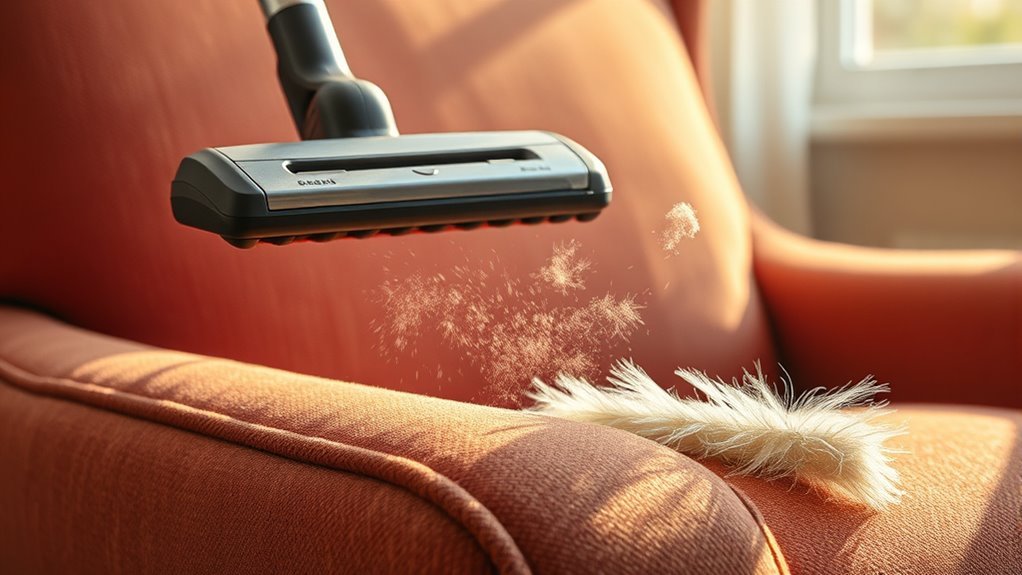
Since dust and debris can quickly accumulate on your chair, regularly vacuuming and dusting its surface is essential to keep it looking fresh and clean. Start by selecting the right vacuum attachments to reach every nook without damaging your chair. Use soft brush attachments for delicate areas and crevice tools for tight spots. When dusting, gentle techniques prevent scratches and preserve finishes.
| Task | Recommended Tool |
|---|---|
| Dusting flat surfaces | Microfiber cloth |
| Vacuuming fabric | Upholstery vacuum attachment |
| Cleaning crevices | Crevice vacuum tool |
| Dusting wood parts | Soft brush |
| Removing pet hair | Rubber brush attachment |
Cleaning Fabric Upholstery Safely
Before you start cleaning, always spot test your fabric in an inconspicuous area to avoid damage. Choose gentle cleaners specifically made for upholstery to keep your chair looking fresh. Taking these steps helps protect your fabric while effectively removing stains.
Spot Testing First
How do you know if a cleaning solution is safe for your chair’s fabric? That’s where the spot testing importance comes into play. Before diving in, you want to make sure your fabric won’t react badly to any cleaner. Here’s a simple way to test:
- Pick a hidden area on your chair.
- Apply a small amount of the cleaning solution using a cotton swab.
- Wait 10-15 minutes to observe any color changes or fabric damage.
- If nothing unusual happens, it’s safe to proceed with cleaning.
Using these spot testing methods lets you protect your chair while keeping your cleaning process stress-free. You’ll enjoy the freedom of a fresh chair without the worry of ruining the fabric.
Choosing Gentle Cleaners
When you’re ready to clean your chair, choosing a gentle cleaner is key to preserving the fabric’s look and feel. You want something effective but not harsh, so the fabric stays vibrant and comfortable. Opt for natural alternatives like diluted white vinegar or mild soap mixed with water. These eco friendly options not only protect your chair but also reduce your environmental footprint. Avoid strong chemicals that can wear down fibers or cause discoloration. Remember, gentle doesn’t mean ineffective—it means smart. By selecting cleaners that respect your fabric and the planet, you maintain your chair’s beauty while enjoying the freedom of a clean, fresh space without worry. Your chair deserves care that’s thoughtful and safe.
Caring for Leather Chairs Without Damage
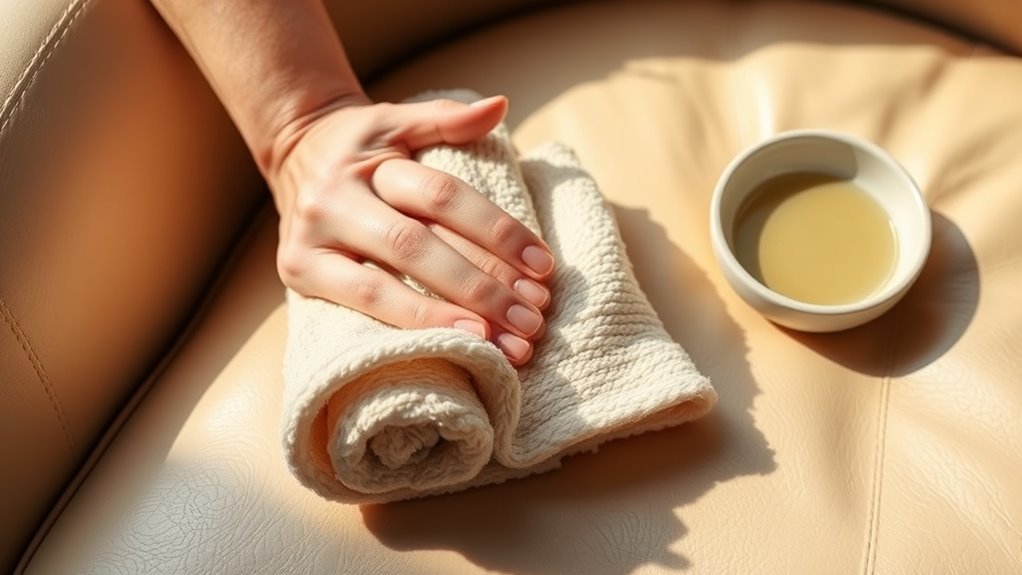
Although leather chairs add a touch of elegance to any room, you’ll need to treat them carefully to maintain their appearance and durability. To care for your leather chair without damage, follow these steps:
- Clean spills immediately to prevent stains—this is key for effective stain prevention.
- Use a soft, damp cloth with mild soap for gentle cleaning, avoiding harsh chemicals.
- Apply leather conditioning every 6-12 months to keep the leather supple and prevent cracking.
- Keep the chair away from direct sunlight and heat sources, which can dry out and fade the leather.
Proper Techniques for Wooden Chair Cleaning
Since wooden chairs can be sensitive to moisture and harsh cleaners, you’ll want to use gentle methods to preserve their finish and structure. Stick to a soft cloth and mild soap to clean without damaging the wood finish. Avoid soaking the wood; instead, dampen your cloth slightly and wipe gently.
Keep your cleaning frequency moderate—too often can wear down the finish, too little allows dirt buildup. Here’s a quick guide to help you find balance:
| Cleaning Frequency | Recommended Action |
|---|---|
| Weekly | Dust with a dry microfiber cloth |
| Monthly | Wipe with damp cloth and mild soap |
| Quarterly | Apply wood polish or conditioner |
| Annually | Inspect for damage and refinish |
Removing Common Stains Effectively
Because wooden chairs are prone to absorbing stains, you’ll want to act quickly and carefully to remove them without harming the finish. Different common stain types demand specific stain removal techniques, so here’s how to tackle them effectively:
Act swiftly and gently to remove stains from wooden chairs without damaging their finish.
- For water rings, gently rub with a mix of baking soda and water, then wipe dry.
- To remove ink stains, dab with rubbing alcohol on a cloth, avoiding excess moisture.
- Grease stains respond well to a mild dish soap solution applied with a soft cloth.
- For food spills, clean immediately with a damp cloth and mild detergent.
Disinfecting Your Chair to Eliminate Germs
When you’ve removed stains, it’s important to disinfect your chair to get rid of germs that can linger on surfaces. Focus on germ hotspots like armrests, seat edges, and buttons, where bacteria thrive. Choose disinfecting methods that suit your chair’s material—sprays with alcohol or specialized wipes work well for most surfaces. If your chair has fabric, consider a disinfectant safe for textiles to avoid damage. Apply the disinfectant evenly and let it sit for the recommended time to guarantee effectiveness. Don’t forget to clean less obvious areas like the undersides and casters, where germs can hide. By using targeted disinfecting methods, you reclaim control over your space, promoting health without sacrificing your freedom to enjoy your chair comfortably and safely.
Drying and Maintaining Your Chair Post-Cleaning
Although cleaning removes dirt and germs, properly drying your chair is essential to prevent mold, mildew, and damage. To keep your chair in top shape, follow these drying techniques and maintenance tips:
Properly drying your chair after cleaning is key to preventing mold, mildew, and damage.
- Air dry your chair in a well-ventilated area, avoiding direct sunlight to prevent fading or warping.
- Use a fan or open windows to speed up the drying process without overheating the material.
- For fabric chairs, consider using a handheld vacuum after drying to lift any remaining dirt or debris.
- Regularly check for moisture buildup in hidden spots to avoid long-term damage.
Tips for Regular Chair Maintenance and Protection
Proper drying is just one part of keeping your chair in great condition. To truly protect your investment and enjoy the freedom of a well-kept seat, stick to a regular maintenance schedule. This means dusting and spot-cleaning spills as soon as they happen, preventing stains from setting in. Using chair protective covers can be a game-changer; they guard against dirt, pet hair, and sun damage, letting you relax without worry. Don’t forget to check your chair’s joints and cushions regularly, tightening screws or fluffing padding to maintain comfort and stability. By committing to these simple habits, you’ll prolong your chair’s life and keep it looking fresh—giving you the freedom to enjoy your space without constant upkeep stress.
Frequently Asked Questions
Can I Use a Steam Cleaner on All Chair Materials?
You might be tempted to use a steam cleaner on all your chairs, but steam cleaner effectiveness really depends on chair material compatibility. Some fabrics and leathers can handle steam, while delicate materials might get damaged. To keep your freedom to clean without worry, always check your chair’s tag or manufacturer’s advice first. That way, you can enjoy a fresh chair without risking any harm to your favorite seat.
How Often Should I Deep Clean My Office Chair?
You might think deep cleaning your office chair is a hassle, but sticking to frequency guidelines can actually free up your time and space. Experts suggest deep cleaning every three to six months, depending on how much you use it. Setting up simple cleaning schedules helps keep your chair fresh without stress. This way, you enjoy a comfortable, hygienic workspace without feeling chained to constant maintenance. It’s all about making cleaning work for you.
Are There Eco-Friendly Cleaning Alternatives for Chair Maintenance?
Absolutely, you can choose natural cleaning methods for your upholstery care that are eco-friendly and effective. Instead of harsh chemicals, try a mix of vinegar, baking soda, and water to freshen up your chair. These natural cleaning alternatives let you maintain your furniture without compromising the environment. You’ll feel freer knowing your space stays clean and green, aligning with your values while keeping your chair looking great.
What Should I Avoid When Cleaning Antique Chairs?
You know what they say: “Don’t throw the baby out with the bathwater.” When caring for antique wood, you should avoid harsh chemicals or abrasive tools that can damage delicate finishes. Also, steer clear of soaking upholstery; instead, protect it with gentle, fabric-safe cleaners. Keeping things mild preserves the chair’s charm and lets you enjoy its freedom without risking harm. Treat your antique chair with respect, and it’ll reward you with timeless beauty.
Can Chair Cleaning Methods Damage Built-In Cushions?
Yes, chair cleaning methods can damage built-in cushions if you’re not careful. When it comes to cushion care, you’ve got to take cleaning precautions seriously—harsh chemicals or too much water can ruin the fabric or padding. You want to keep your freedom to enjoy your chair without worry, so always spot-test first and use gentle, cushion-friendly products. This way, you protect your investment and keep your chair comfy and fresh.
